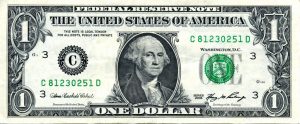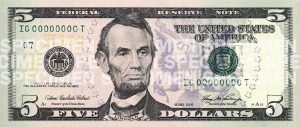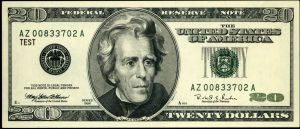
Subject 1: George Washington
America’s first president, and “father of our country,” while an eminent statesman and brilliant general, demonstrates an appalling lack of fashion sense. In fact, his staid appearance gracing the one dollar bill is a total disaster. His hair, billowing down in cottony swirls, obeys no discernible style, shape, or configuration, and looks almost matronly, more like that of a doting grandmother than a happening head of state. Angling down from the apex of his skull and shooting outward into a hilarious one-length wedge, his bobbed hairdo is far too bouncy and playful for such a dignified politician. One can hardly imagine his frilly countenance leading his charges into battle with a hairstyle so ridiculously carefree. But perhaps that was his modus operandi: to mask his revolutionary schemes under the foppish accoutrements of a powder-puffed colonial dandy, then blindside his Tory adversaries when they least expected it.
Judging from the wide open prairie of forehead, G-Dub is obviously afflicted with male pattern baldness, but instead of cutting his losses and opting for a close-cropped hairstyle as the follically-challenged men of the 21st century do, he lets it all hang out in an albino-like sponge of ill-advised growth. What, exactly, was our first president and architect of our democracy thinking? Yes, when it comes to his grooming habits, one cannot tell a lie: they were an abomination.

Subject #2: Abraham Lincoln
Many historians hold that Lincoln was our greatest president. He freed the slaves and helped preserve the Union during the Civil War. However, despite these monumental accomplishments, our sixteenth president was unable to do one thing: achieve a personal grooming style of any distinction whatsoever. Perhaps it was the greasy slant of hair slicked across his forehead, or the skimpy beard shading his jaw line that made Honest Abe such an ungainly goon. Sure, you signed the Emancipation Proclamation, but maybe you should have emancipated your inner style, Abe.
One can offer only feeble conjecture as to how Lincoln arrived at his ill-fated look. But judging from his craggy, mismatched features—the honking nose, large unsavory mole, and drawn upper lip—it’s likely that our sixteenth president may have been the end result of frontier inbreeding. Biographical information paints Lincoln as a gangly, overgrown man, all knees, elbows and ears, of that distinctly long-armed hillbilly ectomorphism still traceable in parts of Kentucky, southern Indiana, and Illinois, where Abe spent his formative years. Or de-formative years, one might say.
It’s easy to get wistful when imagining the style that Lincoln might have created, for the raw ingredients were there. He had a gentle, pilgrim-like appeal that endeared him to folks. Add calming, wisdom-filled eyes and a tuft of chin-beard not unlike those that snowboarders and extreme sports buffs wear, and ‘ole Abe had a peaced-out vibe that could have been milked much further. Sadly, Mr. Lincoln—a fashion victim if there ever was one—was simply too busy with the duties of his administration to pay much attention to his image. The result is one of the worst hairstyles in the history of the United States government. No wonder John Wilkes Booth put Mr. Lincoln’s illadvised growth out of its misery that fateful night at the Ford Theatre.

Subject #3: Andrew Jackson
Happily, Andrew Jackson, a.k.a. “Old Hickory,” sports a much studlier ‘do. Cresting over his long, leonine skull in a windswept mane, A.J.’s wavy bouffant—a tempest of billowing locks tumbling off his skull, tousled and breeze-kissed in all the right places—reigns supreme atop the craggy wedge of his face. His rakish, swept-back hair frames a pair of dark, hypnotic eyes, and with his high-breeched collar and grim, emotionless expression, Mr. Jackson looks more like a Transylvanian count than a chief executive.
Jackson was the scion of an almost royal lineage. He ascended rapidly through the military and engineered some of the greatest victories of the young republic, including the battle of New Orleans. But how he was able to engineer a hairstyle of such effortless body and bounce is even more impressive. In an era entirely devoid of mousse, spritzers, or other styling accoutrements, Old Hickory was somehow able to achieve, and maintain,a hairstyle as carefree as anything in the style-conscious Seventies. Perhaps Mr. Jackson—a fiercely enterprising man—improvised a Victorian gel of some kind, some crude blend of saddle oil and liniment that aided him in creating his hairdo. But more likely than not, it was simply the result of a galloping, on-the-go, let’s-kick-some-Indians-asses lifestyle.
There’s no denying Mr. Jackson’s oaky, rough-hewn appeal. Nor is there any denying how reckless, spontaneous, and full of flair his hairstyle was—however offhandedly it may have been created. His dashing, nonchalant look epitomized our fledgling nation at the time: intense, hurried, and gloriously entitled. With a sixth president with a hairstyle of such verve and confidence, it’s no wonder the winds of destiny were to smile upon our still minty-fresh republic.
So what have we learned by placing these statesmen under such a critical eye, an eye from our jaded, image-centric future? From our three subjects, we’ve learned that it’s much better to be alive today than it was then, especially when you’re trying to develop a smoldering look. Today, even the most pedestrian Duane Reade or Rite-Aid has a treasure trove of grooming and hair care products upon its well-lit shelves, a plethora of lotions, gels, exfoliating mitts, and other pamperings that can render even the humblest of men into a honey-scented Casanova. How our forefathers existed in a time devoid of such grooming products and services is unimaginable. But somehow, they managed. They fought and survived; they dreamed and struggled; for good or bad, each statesman created his own individual look, with each style as fiercely independent as its creator—testament to the expressive spirit of the American people, and to the freedom that our country has stood for since 1776.